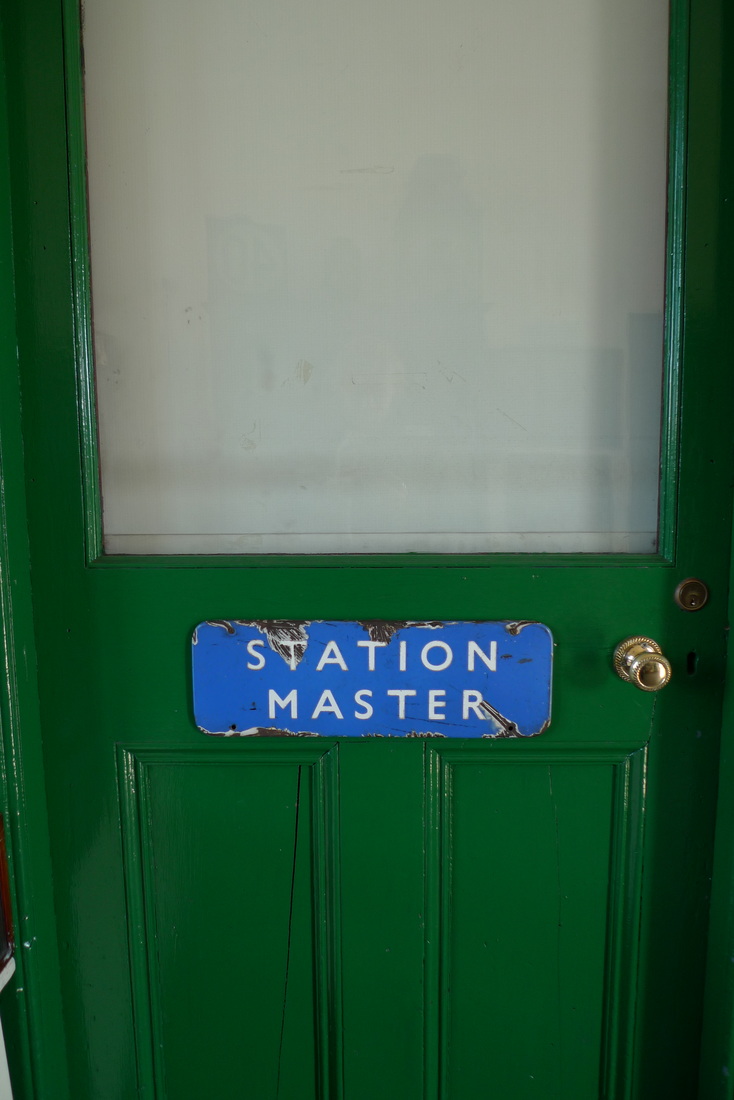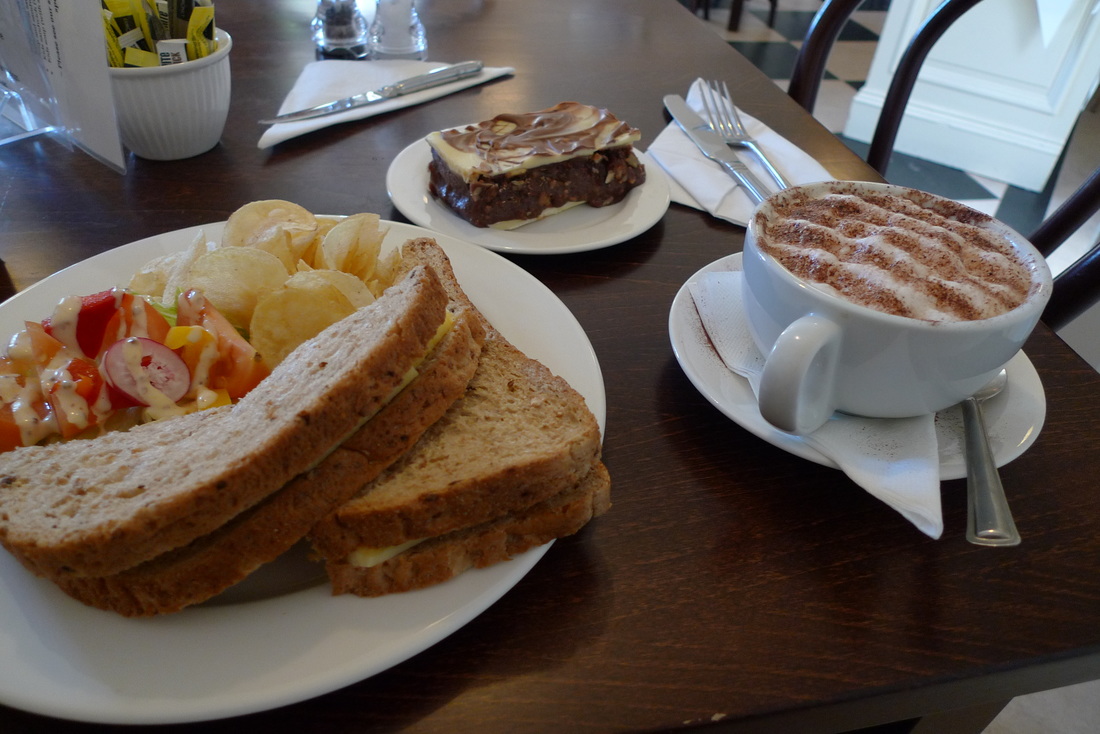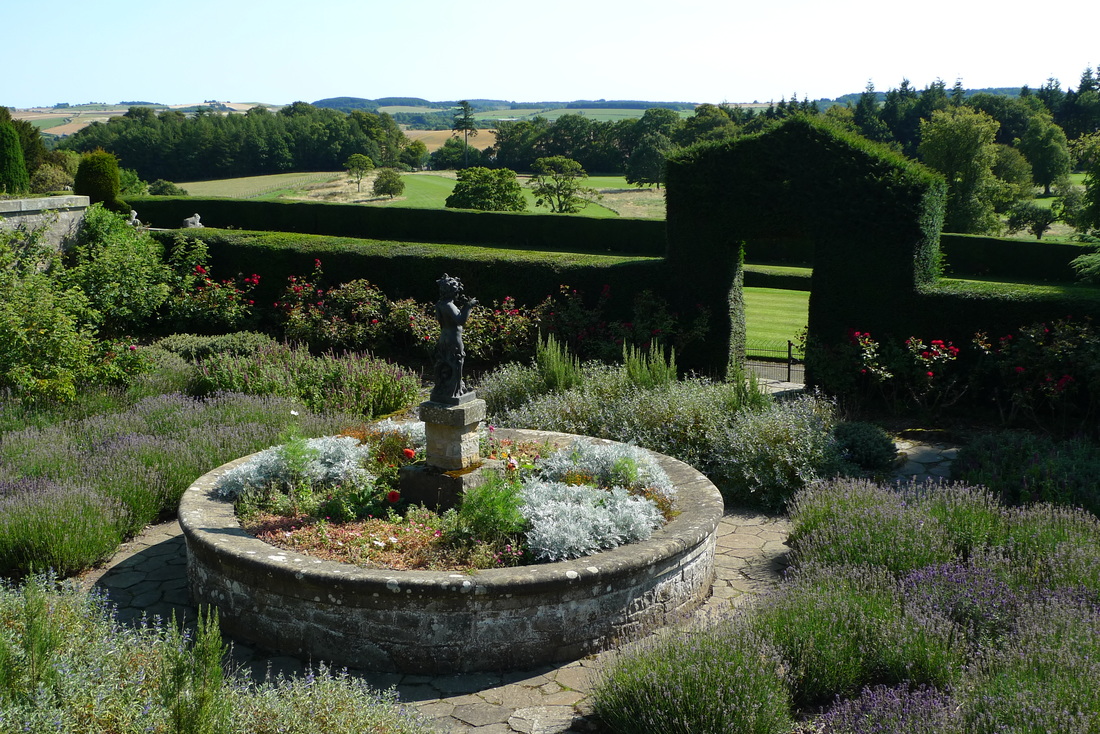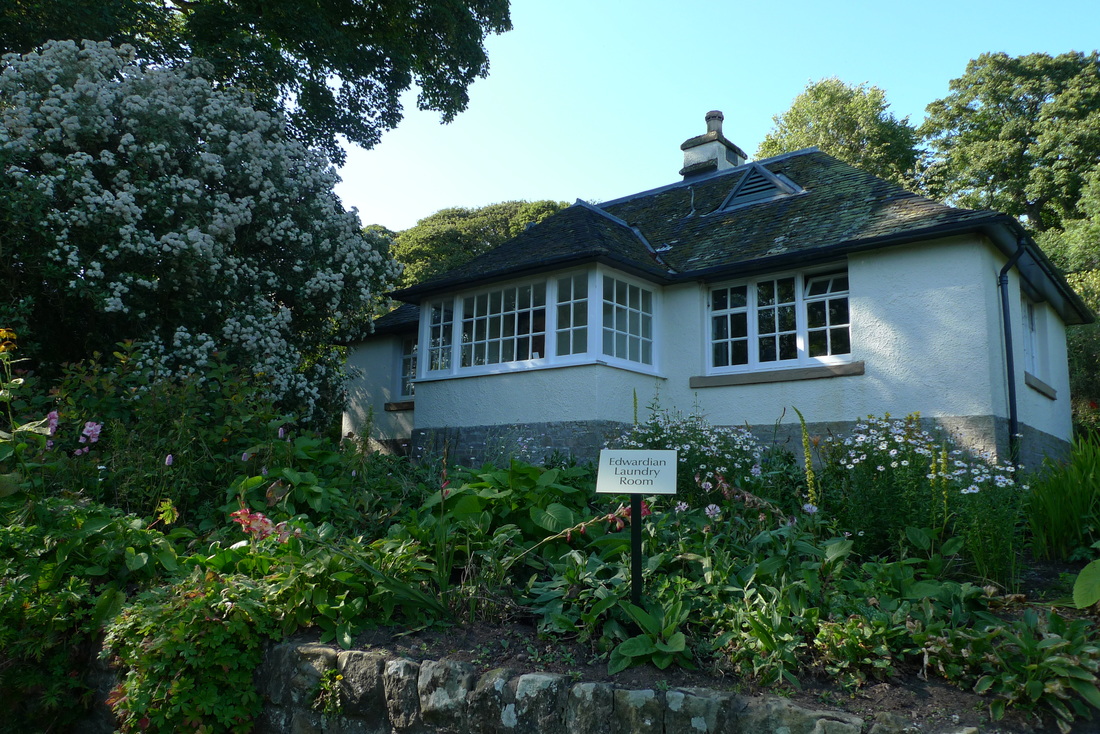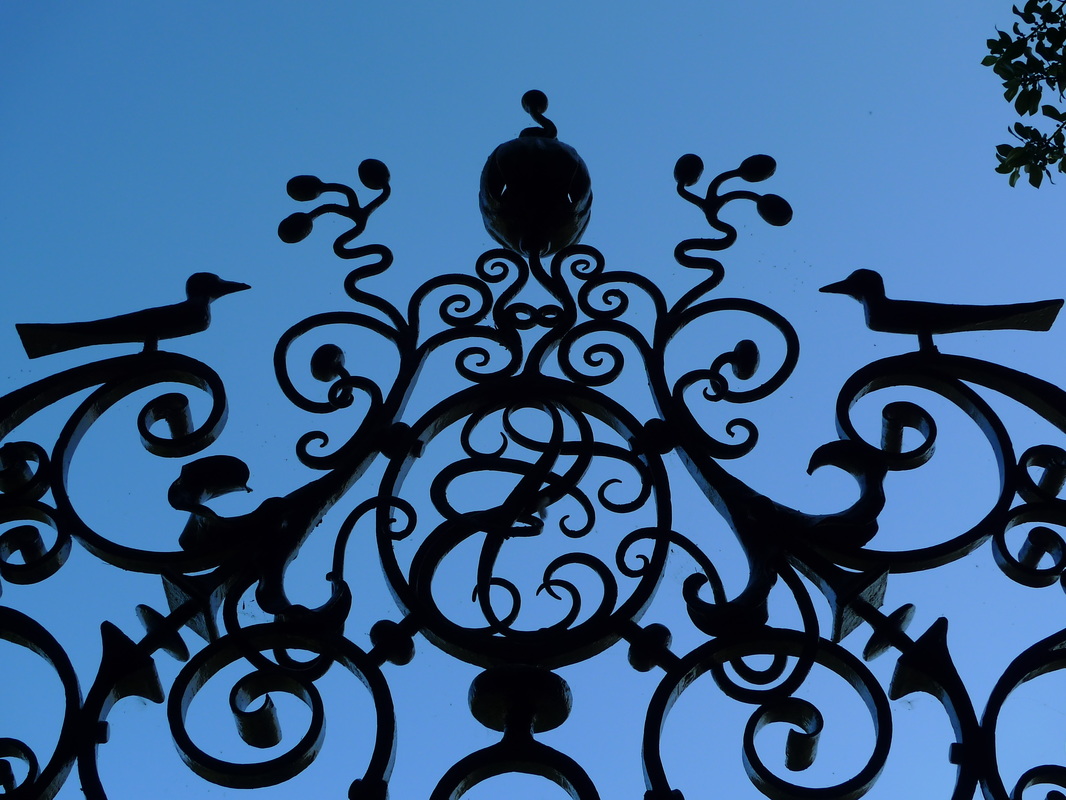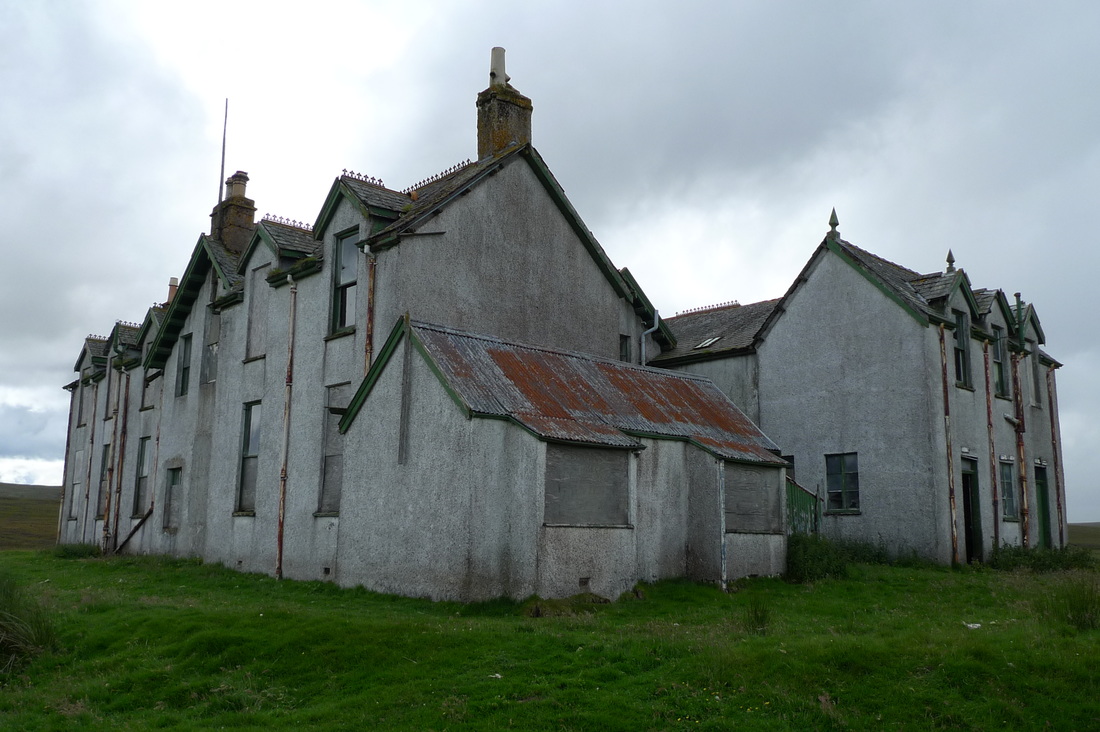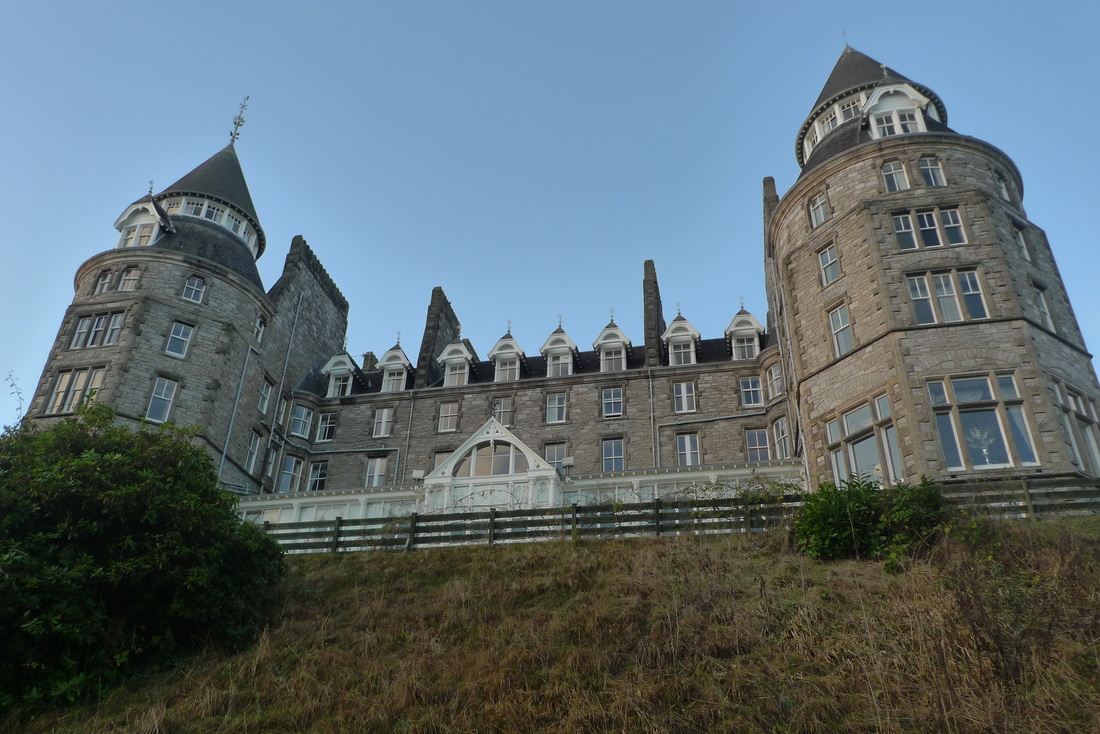|
The guard, resplendent in suit, waistcoat and hat, looked impatiently at his watch. He paced up and down the outside of the carriages. "Come on! We leave at 11," he said to the men connecting the diesel locomotive to the carriages. Then everything is ready and he shouts out, "all aboard!" A whistle is blown, doors are slammed and the engine growls as it accelerates away from the platform.
For an authentic experience of how British Railways used to be the Caledonian Railway is a great day out and easy to reach by bicycle.
Brechin railway station, with its glass canopy, clock and 'Caledonian Railway' sign in decorative ironwork, is joyful. And stepping inside is very much a step back to that golden era of railways that people talk of. Tickets are bought from shuttered hatches and there is a railing, highly decorative, of course, to control queuing at the ticket window.
Walking around the station and the platforms you will find plenty of items that add to the feeling of being in a different century. There are old advertising sings, luggage barrels and even an old car.
I took a seat in a compartment for the novelty value. Railway compartments no longer exist on Britain's railways, so being able to slide shut a door and have a part of the train all to yourself is an experience to relish. The fabric on the seats was worn, some of the springs had gone, but it was so much more comfortable than the seat on the modern train I had taken to Montrose.
Pulling down an armrest and sinking into the seats of a British Rail compartment you cannot help but think that passenger comfort has diminished somewhat in the modern era of railways.
The other carriages have open saloons, where some of the seats have quite striking colour schemes.
All of the staff were dressed to the railway nines, including the young boy who asked "would you like to buy a smashed penny for our boiler appeal? They cost £1." I was curious about what a smashed penny is, so I bought one and found that it is exactly that- a smashed one pence coin, flattened with a heavy duty tool.
This line had closed to passenger traffic in the early 1950s, but since 1993 a preserved railway has run services on a 4 mile section between Brechin and Bridge of Dun. It operates mainly during summer weekends. It is a pleasant ride through farming country.
Both steam and diesel trains operate on the line. During my visit the carriages were pulled by a diesel locomotive. If you have a preference for diesel or steam you should check the Caledonian Railway website to see which services will be running on which dates.
At Bridge of Dun it is worth taking the short trip from the station to the bridge that crosses the River South Esk. The bridge is impressive with interesting architectural flourishes- you can read about it on my blog.
Why not visit the House of Dun? It is a short distance away from Bridge of Dun. Read my blog about the House of Dun
Getting there Take a train to Montrose. It takes around 1 hour, 40 minutes to 2 hours from Edinburgh or Glasgow, depending on which train service you travel on. It is a 4.3 mile cycle from Montrose station to Bridge of Dun, where the Caledonian Railway has a station. The Montrose Basin Cycle Route will take you there, mainly alongside the A935 on a segregated path or on the pavement. After 3.8 miles you come to a sign for Bridge of Dun, take this left turn and at the bottom of this road you will come to Bridge of Dun station. The Montrose Basin Cycle Route is an excellent example of forward thinking by a local authority. The busy A935 makes it daunting to come here on a bicycle, but by making the pavement shared pedestrian and cycle path it has opened up the area to cycle tourism. Some parts of the pavement are very narrow with little space for bikes and people to pass, but they have made the best use of the existing infrastructure to ensure that it is viable to cycle safely in this area.
Other things to see and do
Take the Montrose Basin Cycle Route all the way around Montrose Basin. This is about 10 miles and means that you can do a circular route from and to Montrose station. You could pop in to the Montrose Basin Visitor Centre. Before you reach the turn off for Bridge of Dun you will pass the entrance to House of Dun, a National Trust property where you can go on a tour of the house and explore the grounds. Brechin is worth exploring for interesting architecture and the cathedral.
2 Comments
One of the best things about cycling in Scotland is coming across the unexpected. You can look at a map and research places online to get a pretty good idea about what you are going to see on your travels. But when you come across something that you didn't expect it becomes the highlight of the journey.
When I set out on the Loch Buidhe road between Golspie and Dornoch I had no idea that I would come across this rumbling, tumbling waterfall by the side of the road. There was no warning. It came out of the blue. All of a sudden. There was a gushing waterfall right by the side of the road. I had no idea this was going to be here. There was no mention of it on the map or in anything I read about the area. I loved that. My secret waterfall and I had it all to myself. I stayed here for ages watching it and enjoying the noise.
The waterfall is located a few miles from where this road joins the A9 at The Mound. The road runs alongside a rushing burn, there is a bit of a climb and then the waterfall appears.
There are many secrets, like this waterfall, to be found across Scotland. Yes, there are castles, stately homes, museums, cities and other attractions that are famous and draw thousands and thousands of visitors. But it is the little surprises, the things that are not widely written about, the hidden gems that are often the most memorable.
Read my blog about cycling along this road and discover more surprises
Experience the life of a wealthy jute mill owner at this Edwardian-era home. Play billiards. Admire Rococco plaster work. Discover beautiful antiques. Explore the gardens. A combined train trip and short cycle make it possible to visit this on a day trip from Edinburgh, or take a short detour from National Cycle Route 1.
Getting there From Cupar station it is only a 2.5 mile cycle to the house (map at bottom of this page). Having a bicycle makes it convenient and easy to reach the house using public transport. Edinburgh to Cupar by rail takes just under 1 hour. Cupar is 20 minutes from Dundee. How to make your tearoom stand out from the competition? Put a Model T Ford van on the roof. You will pass the Fisher and Donaldson bakery on the way to the house.
The A916 curves up towards the house. A word of warning- this is a tough hill that will give your legs a workout, but the reward is the superb views of rolling countryside. On the way back the freewheel to the bottom of the hill will pump you full of adrenaline.
House of Fun
The motto of Hill of Tarvit Mansion is "a grand day out" and you will see this on the sign at the start of the driveway leading to the house. There is an emphasis on having fun and trying out some of the games that were a major part of the Edwardian household. I love the fact that you can try out the billiard table. I cannot think of any other stately homes that let you touch the billiard table, ever mind play on it.
In the parlour you can play card games, tiddly winks and snakes and ladders. There is a hickory golf course on the lawn and you can rent clubs and collect a score card.
The score card is on the back of the visitor map. This looks really enticing with the quality drawings and use of colour to highlight the green lawns, rose garden and woods. It made me excited about exploring the site.
The Sharp family made their money in the Dundee jute industry. This versatile material was used to make items like ropes, sailcloth, aprons, carpets and tents. At one time there were around 60 jute mills in Dundee, employing more than 50,000 people.
The family wealth is evident throughout the house. I was particularly impressed by the plaster wreath around the cupola on the first floor. It portrays corn in the cob, sunflowers, grapes, marrow and pineapple with incredible precision.
The bathroom in this house is enormous. There is a serious looking shower with taps marked "spray", "plunge" and "ascending spray". This is the type of gear I would expect to find in a a modern luxury hotel, but the Sharps had it in the 1920s.
Above the toilet there is a strange ornament of toads fighting with swords, with one stabbing the other. You are not permitted to take photographs in the house, but I was able to take a photo of the visitor toilets. It was nice to discover that there is an original Edwardian WC with porcelain bowl, wooden seat and high level cistern.
Nothing but the best
In the dining room there was a very enthusiastic guide who pointed out the silver galleon table decoration. "Look at the detail, even has men on it." There is a sailor climbing the rigging, one in the crow's nest and one at the wheel. There is a dragon on the prow of the ship and the decking even has the wood grain showing. The room also had a silver rabbit, pheasant and squirrel. "Their heads come off and there are glasses inside for drinking liqueurs, " the guided told me. "Isn't that marvelous?" With so much silver in the house it must have been a job keeping it clean. The sink in the kitchen has three taps, one of which deposited rain water, "ideal for cleaning silver," the guide told me. She was keen to draw my attention to the door from the dining room to the kitchen, "just look at the quality. Mahogany. Nothing but the best."
Sir Hugh Sharp was a collector of first editions and his library included a rare Alice in Wonderland of which only 22 copies were produced. This was because Lewis Carrol did not like the illustrations and pulled the print run.
Sir Hugh loved climbing and in his bedroom here are black and white photographs of him scaling the Alps in the 1920s. He pioneered skiing in the Scottish Highlands. He received many medals for his courage in World War One and in the bedroom there is an interesting portable gramophone from that time. It was nicknamed 'The Trench' and designed for front line service. It is thought that over 100,000 of these gramophones were sent to the trenches to help raise the morale of the troops. Despite the obvious wealth in the house I felt that it was cosy and not intimidating. It is not a huge house and on a much smaller scale than many of Scotland's stately homes. Time for tea There is an elegant tea room with chequerboard tiles, wooden tables and an extensive selection of home baking displayed on a sideboard. You can also get soup and sandwiches. It is a nice spot to relax with a coffee and they also have seating outside for when the sun is out.
A walk in the gardens
The gardens are small, but full of colourful and sweet smelling flowers.
There is an Edwardian laundry house in the grounds. Inside there is an incredible collection of items, including sinks, mangles and washboards. An information panel describes the life of a laundry maid which involved starting work at 5:00 am and only getting half a day off per week.
The most fascinating part of the laundry room is the drying racks that are pulled in and out on rails. Laundry could be hung on these and then the racks pushed back in where the items would dry from the heat of the boiler. The quality and craftsmanship of these racks is impressive, with chunky brass handles and wood panelling with iron surround. It gives a very visible indication of the industrial scale of keeping a wealthy household crisp and clean.
Up on the hill
The hilltop walk is the highlight of the grounds of Hill of Tarvit Mansion. At the top of the garden there is an iron gate topped with a flourishing decoration that features two little birds. You pass through this gate to start the hilltop walk
You walk through a small wood, a peaceful spot of gently rustling branches and shafts of sunlight on the grass. One of the trees had a swing attached to a branch and I could not resist having a go on it.
At the top of the hill sheep graze and the view is incredible. There are parcels of farmland interspersed with trees as far as the eye can see. It must have been a joy living in this house and being able to admire the surrounding landscape from this vantage whenever you wanted.
There is a 19th century doocot in the grounds, which is in the form of a mini castle. The pigeons kept here would have provided the estate with eggs and meat.
Whilst you are at Hill of Tarvit Mansion you should also visit Scotstarvit Tower. It is located across the road from the main entrance to the Mansion. My next blog has information about this.
Hill of Tarvit Mansion makes for a great day out and is really easy to reach using train and bicycle. At 2.5 miles it is not much of a bike ride, but you will get exercise exploring the grounds on foot, particularly if you do the hilltop walk. If you are cycling on National Cycle Route 1 the house is only a one mile diversion from the route. Cycle to the Secret Bunker. From Cupar you can cycle to a secret nuclear war bunker, a fascinating visitor attraction. Read my feature about cycling to Scotland's Secret Bunker A beer from the Orkney Islands, located off the north coast of Scotland. From the first taste I adored it. The hops and fruit taste are well balanced. Definitely one for after a bike ride on a summer evening. The bottle labeling evokes the romance of island life with a cottage facing a sunset. Swannay Brewery opened in 2005 on the mainland of Orkney. The small scale of the operation and the story of the father and son brewing team is appealing to travellers who seek out locally sourced food and drink. The name of the beer is a play on the taste of hops and the 70 islands of Orkney.
From the very first taste I thought 'mmm! I like this.' Some beers take several sips or more to get a taste for them, but not this one. It was delicious straight away. I reckon this is because there is no single taste that dominates, the fruit and hop taste are equally balanced. On the front of the bottle they call it a "session beer" meaning that it is ideal for drinking one after another on a night out. I really enjoyed this beer and I will definitely be having it again.
I was thrilled to have a piece of my writing printed in Wanderlust travel magazine (April 2016). I was runner up in a writing competition that had cycling as the theme. The piece is about a trip to Altnabreac, one of the most isolated railway stations in Scotland. You can read it here. The winner of the competition is on the left page and I am on the right-hand page.
Favourite buildings in Scotland. Celebrating the Year of Innovation, Architecture and Design 20169/7/2016
2016 is the Year of Innovation, Architecture and Design. It is being celebrated through numerous events across Scotland, including a public vote for the nation's favourite building of the last 100 years. I would like to share with you my favourite buildings in Scotland.
In no particular order: Wemyss Bay station
I think that Wemyss Bay is the most beautiful station in Scotland. It was built in 1903 and has an enormous circular glass roof. It radiates upwards and outwards from the round ticket office. All this glass lets the light come flooding onto the colourful flower displays that grace the concourse. Wooden decking and wrought-iron archways lead you towards the ferry that departs for the Isle of Bute. The exterior of the building has a sixty-foot clock tower and a Shakespearean quality with gables and half-timber framing.
Corgarff Castle
This bright white building sat all alone within a vast remote and unforgiving landscape sparks the imagination. The first time I saw a picture of this I kept dreaming about visiting it. A tiny white speck within the majesty of Scotland's wilderness. It is located about 15 miles from Ballater. The castle dates from 1550 and was later adapted, with the star-shaped defensive perimeter, as a barracks for government troops. It was used as a base for patrols that searched for local people wearing kilts (which had been made illegal) or apprehending smugglers.
Dalnawillan Lodge
A closed and boarded up hunting lodge in a remote and difficult to reach location. You can reach it using Altnabreac train station, a request stop, 100 miles north of Inverness. From there it is a 3.7 mile cycle to reach the lodge. Places like this are so evocative of the power of Scotland's wilderness. People attempt to tame these places and build hotels, but ultimately the land wins out.
Atholl Palace Hotel
Scotland's classic Victorian-era spa hotel. It opened in 1878 as a hydropathic, a branch of medicine that involves the use of water for therapeutic purposes. Much of the original interior survives, including large public rooms with fire places that blaze in the winter months. Best of all are the turret rooms at the very top of the hotel with their 360 degree windows looking onto mountains and stunning sunsets and sunrises.
Dunrobin Castle train station
This was built in 1902 as the private station for Dunrobin Castle, the seat of the Duke of Sutherland. There is no other station like this in Scotland, built in English Arts and Crafts style. You can still take a train here. In the summer months the regular Scotrail trains stop at Dunrobin Castle on request.
Kilmodan Church
Scotland has many very pretty countryside churches. Kilmodan is blessed with Georgian symmetry and architectural features, like huge arched windows that let the light flood in. I love that the chain for the bell is on the on the outside of the church and you have to resist the temptation to give it a go. Inside there are three separate galleries with their own staircases. Kilmodan is located on the Cowal peninsula 17 miles west of Dunoon.
Lagavulin distillery
Whisky distilleries on the island of Islay have a unique look. They are all painted white with the name of the distillery written in huge black capital letters. There are 8 distillieries located on this one tiny island and all of the buildings are pretty, but Lagavulin is my favourite.
The Round Church
Also on the island of Islay, the Round Church has to be the most unique church design in Scotland. The reason for it being round is so that there is no corner for the devil to hide in. It was built in 1767 and sits high up, overlooking the town of Bowmore.
Newhailes
This house is located near Musselburgh, 5 miles from Edinburgh. Designed in 1686 by an architect called James Smith who had 32 children. I love the proportions and symmetry of the building. The interior has been deliberately left untouched, in a state that the last occupant left it in 1997. This gives it a much more lived-in feel than many stately homes. I found it easy to imagine curling up with a good book in an armchair next to the fire in the library.
Syre Church
My favourite church in Scotland. Small, simple and so beautiful. It was built in 1901 and made of corrugated iron. The landscape is stunning and emotional. The Highland Clearances occurred on this land, where families were forcibly evicted to make way for sheep farming. Open the door and take a seat on a pew and spend a few minutes thinking about that time.
Victorian Toilets
The most beautiful toilets I have ever seen are located in Rothesay on the Isle of Bute. They are clad in marble, mosaics and decorative tiles. They date from 1899 and incredibly everything works and you can still use them. The one catch is that they are male toilets, so if you are a woman you have to wait until they are empty to take a look inside.
Innerpeffray Library
This is Scotland's first free lending library, founded in 1680. It is a small, simple, white washed building with large windows to let the light flood in. The walls are lined with bookcases that contain 5000 volumes, mainly rare, old and fascinating books. The best thing is that these books are not locked away- you can handle them, read their words, look at the illustrations. Innerpeffray is 4 miles south of Crieff.
Mull of Kintyre Lighthouse
I have always loved lighthouses. Located at the extremes of our land they are the ultimate symbol of man against nature. This lighthouse requires travel on an extreme road, the last part of which is too tortuous for driving and even cycling. You must walk. The buildings, dating from 1788, are gleaming white and because they are rented out as self-catering accommodation you are able to have a look around and walk right down to the rusting fog horn from where the coastal views are magnificent.
Cottages of Seatown
Seatown is a part of the town of Cullen, located on the North Sea coast. The collection of hundreds of small fishermen's cottages is a delight to walk around. I am not choosing just one cottage for this list of favourite buildings, but it is the effect of so many, of different designs, sizes and colours that means all of Seatown goes on the list. Although many of the cottages are now holiday homes there is a strong feeling of a connection to the past when you walk around and imagine fishermen and their families back in the day.
Craigard House
Two brothers, owners of rival whisky distilleries, competed to build the finest house in Campbeltown. Craigard House (1882) was the result. It is now a hotel, which gives the opportunity to experience something of the lifestyle of a successful nineteenth century businessman. I fell for the finely detailed cornices, stained glass windows and mosaic floor tiles. It is not an intimidating place, like many grand mansions, but a homely abode where you can feel relaxed. The view of Campbeltown Loch from the dining room can be almost Mediterranean on a sunny day, appropriate to the Italianate architecture of the house.
|
|







